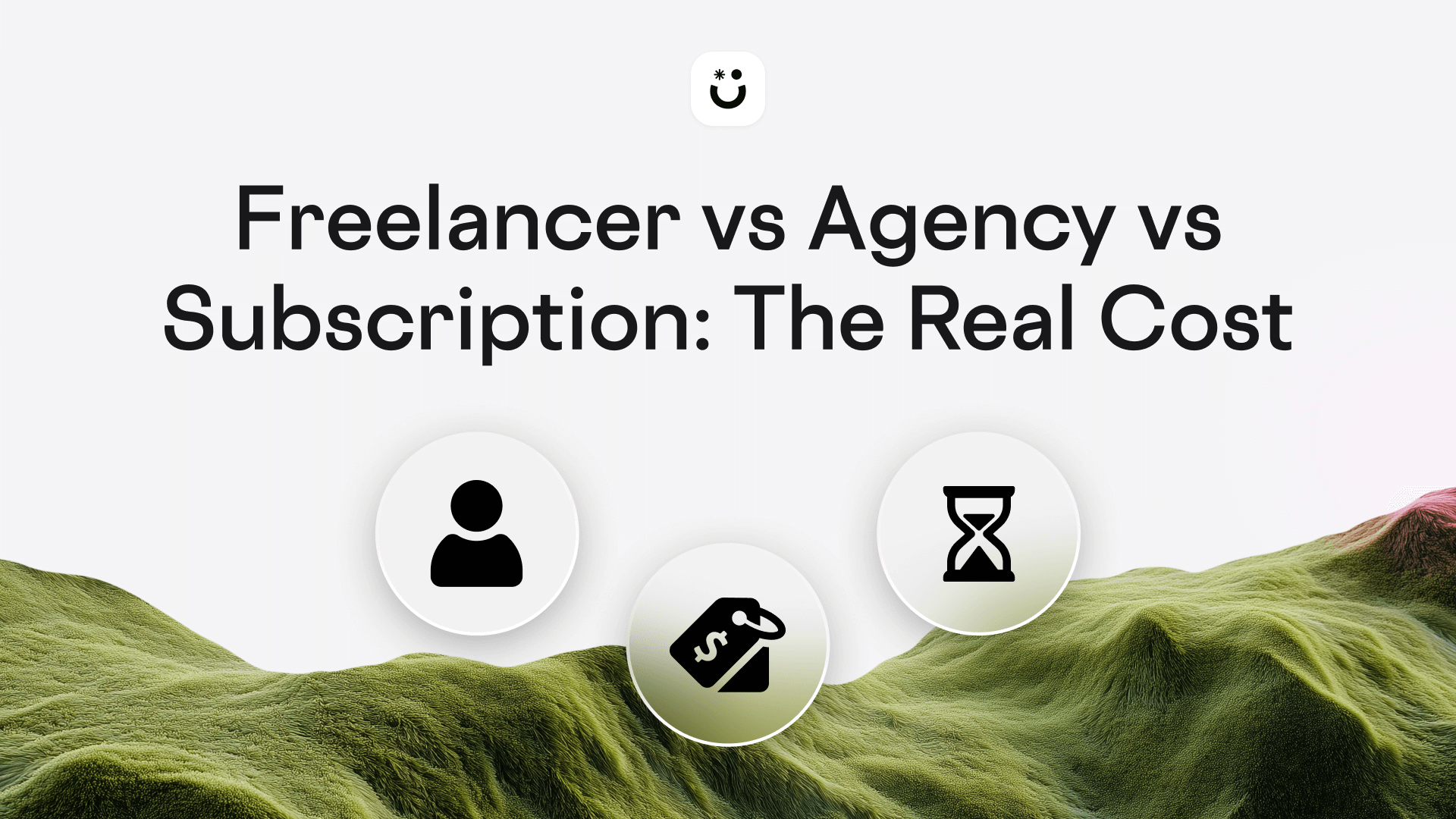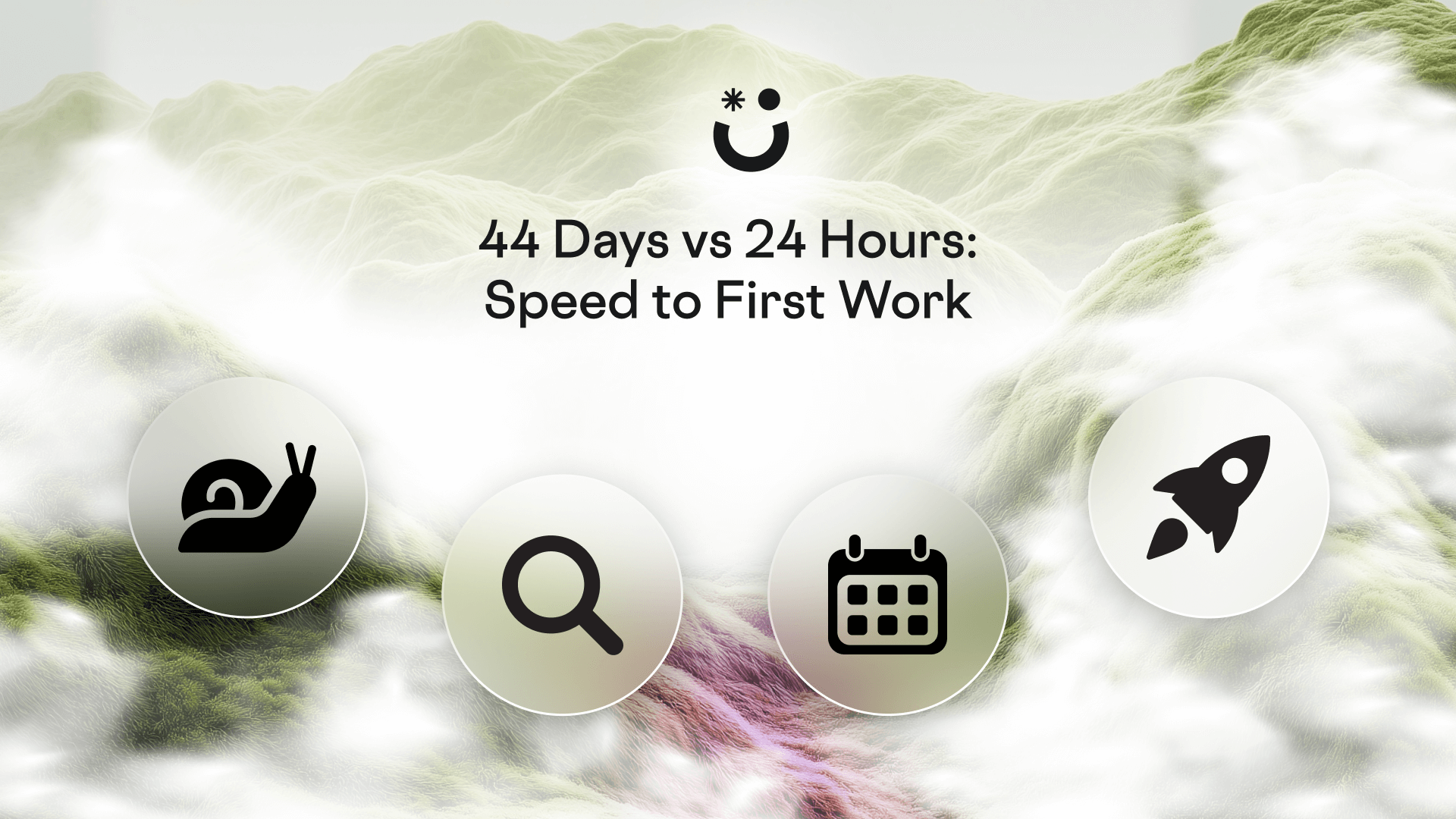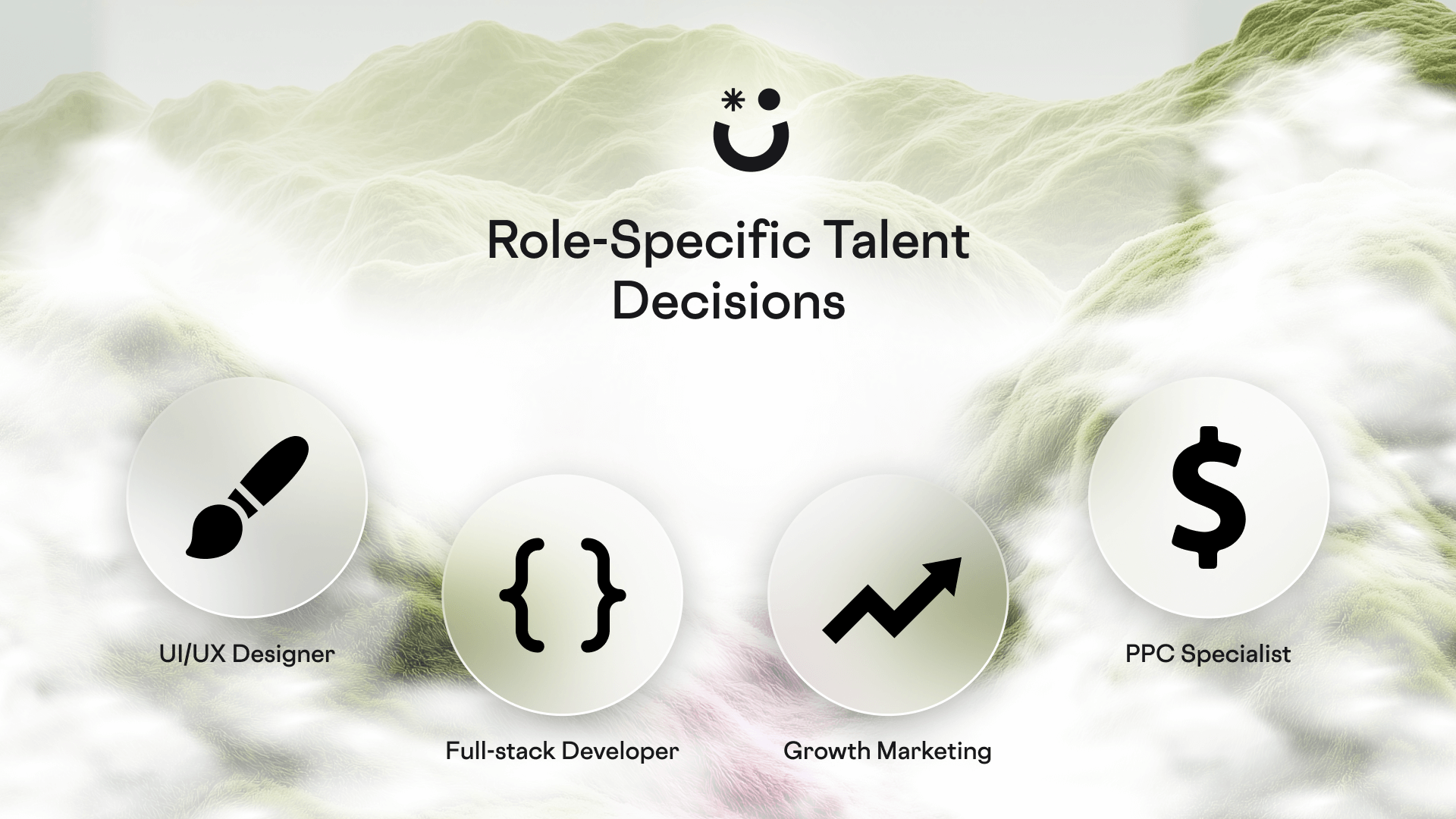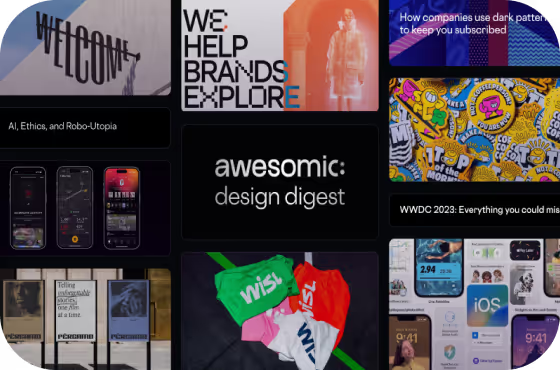Freelancers vs Agencies vs Subscriptions: The Role-by-Role Breakdown


Why this decision matters in 2025
In America, approximately 72.9 million independent workers operate. The talent supply side has exploded, but that doesn't make the choice easier. If anything, the proliferation of options has made selecting the right talent model more complex.
Consider the baseline economics: when you hire in-house in the US, benefits alone cost employers an additional $13.58 per hour worked, representing 29.8% of total compensation for private industry workers, according to a recent report from the U.S. Bureau of Labor Statistics (BLS). That seemingly reasonable $75,000 salary suddenly incurs a true cost of over $97,500. Meanwhile, the traditional hiring process still averages around 44 days from posting to placement by SHMR’s 2025 report, which is nearly a month and a half of lost productivity while you search, screen, and onboard.
This reality has pushed startups that need to move fast to conquer markets towards flexible models. But which one? The answer depends entirely on your role requirements, budget predictability needs, and speed-to-market pressures.
The problem with traditional freelancing for Product, Design, and Growth
Traditional freelancing promised freedom from the overhead of full-time hires. In practice, it can introduce hidden costs and coordination headaches that can derail startup momentum.
The hidden cost structure
When you hire a UI designer on a freelance platform, let’s use Upwork’s median rate of $30 per hour as an example, you're not just paying for design time. You may also need to factor in:
- Platform fees (typically 5-20% depending on contract value and platform)
- Time spent reviewing portfolios and conducting interviews
- Project scoping and skills needed as requirements evolve
- Communication overhead for async coordination across time zones
- Quality assurance and revision cycles
- The opportunity cost when your chosen freelancer becomes unavailable mid-project
A US-based WordPress developer charging $20 per hour might seem budget-friendly compared to a full-time hire. But when you account for the 15-20 hours you'll spend managing the relationship, reviewing code, and handling knowledge transfer, that accessible rate starts climbing toward off-charging the work to an agency.
Speed cariability and the scheduling dancing
Talented freelancers usually maintain multiple client relationships. A Freelancermap survey found that over 57% of freelancers had more than 1 client at a time. Your urgent landing page revision may compete with three other projects for your freelancer’s attention. The result? What should be a two-day turnaround can stretch to a week.
The scheduling dance can also become particularly painful for iterative work. Need daily adjustments to your PPC campaigns based on performance data? Good luck coordinating that with a freelancer juggling multiple clients.
Quality assurance roulette
Without standardized vetting processes, every freelancer hired on an open platform is a gamble. Yes, portfolios and reviews help, but they don't guarantee:
- Consistent quality across different project types
- Adherence to your specific brand guidelines
- Code that meets your technical standards
- Designs that consider your full product ecosystem
The revision cycle becomes a negotiation. Does "unlimited revisions" really mean unlimited? At what point does feedback become scope creep that requires an additional payment? These gray areas create friction that compounds over time.

What a subscription-based talent model changes
The subscription model for talent isn't just freelancing with monthly billing. It fundamentally restructures how startups access specialized skills, shifting from transactional relationships to ongoing capacity you can tap as needed.
Instead of hunting for available talent when projects arise, subscription-based talent matching apps maintain benches of vetted professionals. You're not hiring a person, you're getting access to a capability. When one designer is unavailable, another steps in. When your needs shift from UI to brand design, the service adjusts without requiring a new hiring process.
The pricing model changes everything. Rather than variable hourly costs that balloon with scope creep, you pay a predictable monthly fee. This transforms talent from a variable cost requiring constant management to a fixed operational expense you can budget against.
Most critically, these services optimize for throughput rather than just output. Daily updates become standard. Async collaboration gets built into the workflow. The question shifts from "When can you deliver this?" to "What should we tackle next?"
Model comparison: Subscription vs Freelancers vs In-house
Pricing & total cost of the models
Let's ground this comparison in real US market data for three key roles: PPC specialists, web developers, and UI/UX designers.
Freelancer costs, based on public data, median Upwork rates at 100-160 hours/month. In-house costs derived from salary data plus 29.8% benefits load.
The PPC specialist comparison illuminates the trade-offs. Salary.com reports an average PPC specialist salary of $77,579, while Indeed shows $66,098. Taking the midpoint of roughly $72,000, adding the 29.8% benefits load, brings the true annual cost to $93,456 - or $7,788 monthly. Compare that to PPC agency management fees ranging from $2,000-$8,000 per month, or a subscription service at a fixed $4,500 monthly, and the economics shift based on your needs.
For growth marketing managers with deep expertise, the spread widens further. Salary.com reports an average salary of $123,256, while ZipRecruiter reports $83,488. Even at the lower figure, with benefits, you're looking at $108,367 annually—over $9,000 per month in true cost. Suddenly, that agency retainer or subscription service looks remarkably efficient for startups not ready for a full-time senior hire.
Marketing agencies will, of course, have their own rates, but they usually sit between freelancing and full-time.
Speed and how often work gets done
The speed differential becomes stark when you map it to actual projects. A startup needing new landing page variations for A/B testing could reasonably face these timelines:
- Freelancer path: 3-5 days to find and vet talent, 2-3 days for initial concepts, 2-3 revision cycles at 1-2 days each. Total: 10-15 days.
- Agency path: 2-3 days for kickoff and scoping, 5-7 days for initial delivery, 3-5 days for revisions. Total: 10-15 days.
- Subscription path: 24 hours to brief, 24-48 hours for initial delivery, 24 hours per revision. Total: 3-5 days.
The compound effect over multiple projects is dramatic. Running consistent weekly growth experiments with different skillsets required is feasible with subscription services or in-house teams, but can become almost impossible with traditional freelancer or agency models.
Quality and QA of the work
Quality assurance varies dramatically across models, with implications for both immediate output and long-term brand consistency. Recent reports show that investors tend to prefer solid brands over other options.
Agencies typically maintain formal QA processes. Creative directors review work, account managers ensure brand compliance, and project managers verify deliverables match specifications. This systematic approach delivers consistency but adds time and cost. The UX/UI agency pricing reported by Clutch reflects these quality layers.
Freelancers offer variable quality depending on individual standards. Top-tier freelancers commanding above-median rates often deliver exceptional work, but you're responsible for all QA. Miss a detail in your brief? That's a revision cycle. Need to ensure accessibility standards? You'll need to verify yourself, hire additional QA support, or hope they hit it out of the park in the first try.
Subscription-based talent matching apps typically vet their talent pools, creating baseline quality standards. The bench depth means they can match specialists to specific needs. This means your WordPress development project gets a WordPress expert, not a generalist developer learning on your dime.
In-house teams provide the gold standard for quality control and brand consistency, since you’ve vetted and most likely trained them to your company’s baseline quality. They know your product, understand your standards, and continually improve. But this also comes at the cost of full-time salaries plus that 29.8% benefits load and hidden costs that can represent a double of annual salary until they settle in their position.
Reliability and scalability for your team
The reliability question often determines model choice for mission-critical work. Let's examine each model's continuity risk:
Freelancers represent single points of failure. When your go-to Webflow developer, charging $31 per hour takes another project over yours or goes on vacation, you're back to square one. The relationship you've built, the context they've accumulated, gone. You can maintain a bench of freelancers, but that multiplies your management overhead.
Agencies provide institutional continuity. Account teams ensure knowledge transfer, and multiple team members can step in if needed. But scaling up means expanding your retainer or paying more fees. Scaling down? You're often locked into minimum commitments or notice periods.
Subscription services balance reliability with flexibility. The bench model means coverage continues even when individual contributors are unavailable. Scaling happens within your subscription tier. Need more throughput this month? The capacity exists. Slower period? You can run experiments that require different skill sets covered by the subscription.
In-house teams offer maximum reliability for steady-state work but minimal scalability. Sudden need for extra capacity? You're back to hiring cycles averaging 44 days. Need to cut burn rates related to talent? Severance, unemployment insurance, and morale impacts follow.
Risk and compliance: risks and benefits
The compliance landscape adds another dimension to model selection, particularly for startups handling sensitive data or operating in highly regulated industries.
- Intellectual property considerations vary significantly. Freelancer agreements require careful drafting to ensure work-for-hire status and IP transfer. Agencies typically include IP transfer in standard contracts, but verify the specifics. Subscription services usually bundle IP transfer into their terms, while in-house employees' work automatically belongs to the employer under US law.
- Data security becomes critical for growth marketing and development work. That PPC specialist needs access to your ad accounts, analytics, and possibly payment methods. Freelancers typically lack formal security protocols. Agencies may have SOC 2 compliance or similar certifications. Subscription services vary widely. In-house teams operate in accordance with your security policies and training.
- Worker classification risk lurks in the freelancer model. Treat a freelancer too much like an employee (set hours, provide equipment, exclusive relationship), and you risk misclassification penalties. Agencies and subscription services handle classification on their end. In-house employees clearly fall under employment law, with all associated protections and obligations.
- Non-disclosure agreements seem simple but prove complex in practice. Individual freelancer NDAs require enforcement against individuals who may lack assets. Agency NDAs provide institutional accountability. Subscription services typically include confidentiality in their service agreements. In-house employees sign comprehensive confidentiality agreements as part of onboarding.

Role use cases (US market)
UI/UX designer: Hire or not hire?
The design needs of a startup evolve rapidly from initial MVP to market-ready product to scaling brand. Each phase favors different talent models.
When subscription wins: For startups in active product development with weekly design needs, subscriptions deliver unmatched velocity. Companies like Willow and Perseus, both having raised millions, leverage subscription-based talent matching apps to maintain design momentum without the overhead of full-time hires. The ability to submit requests daily and receive updates within 24-48 hours transforms design from a bottleneck to an accelerator.
Consider the economics: at $30 per hour median rate for UI designers and $27 for UX designers, a modest 30 hours of work weekly totals $810-$900, or roughly $3,500-$4,000 monthly. Add platform fees and management time, and you're approaching $5,000. A subscription at $3,500-$4,500 monthly includes vetting, management, and continuity - often proving more economical for consistent needs.
When freelance wins: Single, well-defined projects with clear endpoints favor freelancers. These bounded projects let you tap specific expertise without ongoing commitment. The key is genuine project definition, "ongoing design support" isn't a project, it's a relationship which can be served by subscriptions or in-house hiring.
When in-house wins: Once product-market fit emerges and design becomes strategic rather than tactical, in-house talent can pay dividends. The deep product knowledge, stakeholder relationships, and ability to influence product strategy justify the premium of salary plus benefits. But remember that true cost - a $90,000 designer costs you $116,820 with benefits.
Full-stack developer: Hire or not hire?
Development work carries unique considerations around code quality, technical debt, and system knowledge that heavily influence model selection.
When subscription wins: Startups needing consistent development velocity without the commitment of full-time hires find subscriptions ideal. Feature development, bug fixes, and maintenance work flow naturally through subscription models. The vetting eliminates the risk of hiring a developer who claims full-stack expertise but struggles with your specific stack.
The WordPress versus Webflow developer pricing spread illustrates stack-specific economics. WordPress developers average $20 per hour on freelance platforms, while Webflow developers command $31 per hour. It’s a 55% premium. A subscription service smooths these variations into predictable monthly costs while ensuring you get appropriate expertise for each task.
When freelance wins: Specialized technical projects requiring deep expertise in specific technologies work well with freelancers. Need to optimize your PostgreSQL queries? Implement a complex integration? These focused technical challenges benefit from bringing in specialists for bounded engagements. The key is ensuring strong technical documentation and knowledge transfer protocols.
When in-house wins: Core platform development and architecture decisions usuallydemand in-house talent. The accumulation of system knowledge, the ability to make long-term technical decisions, and the ownership mentality justify the investment. But factor in the full cost - that $120,000 senior developer actually costs you $155,760 with benefits. For pre-product-market-fit startups, that's often capital better deployed elsewhere.
Security and IP considerations weigh heavily in the development model decision. Freelancers accessing your codebase create potential vulnerabilities - both technical and legal. Agencies and subscription services typically provide additional security layers and liability coverage. In-house developers operate under your security protocols and employment agreements, offering maximum control but also maximum responsibility for security practices.
Growth Marketing Manager: Hire or not hire?
Growth roles blend strategic thinking with hands-on execution, creating unique challenges for talent model selection.
When subscription wins: Early-stage startups needing to test channels quickly benefit enormously from subscription models. You can access PPC expertise one week, SEO optimization the next, and email campaign development after that, and all within the same subscription. This flexibility proves invaluable when you're still discovering which channels drive growth.
The cost differential is striking. Growth marketing managers average between $83,488 and $123,256 annually - call it $103,000 at the midpoint. With benefits, that's $133,694 yearly or $11,141 monthly. Meanwhile, PPC agencies charge $2,000-$8,000 monthly plus typically 10-20% of ad spend. A subscription service at $4,000-$6,000 monthly provides similar expertise without percentage-based fees that punish success.
When agency wins: Large, integrated campaigns requiring multiple specialists working in concert favor agencies. Launching in a new market? Running a Super Bowl campaign? The agency model provides the coordination layer and diverse expertise these complex projects demand. Just understand the commitment - most agencies require 3-6 month minimums and charge setup fees that can reach five figures.
When in-house wins: Once you've identified repeatable growth channels and need someone thinking about growth strategy full-time, in-house hiring makes sense. The ability to deeply understand your customer, work directly with product teams, and own the growth roadmap justifies the premium. But early-stage startups rarely need this depth immediately, Sp subscription or agency models to provide more flexibility during the experimentation phase is a favorite among many leaders..
The multichannel nature of modern growth marketing particularly suits subscription models. Running PPC requires different skills than email marketing or content strategy. Subscriptions let you access specialized expertise for each channel without hiring multiple specialists or finding that unicorn who excels at everything.
How each model works in real life?
Real-world applications can illuminate how these models play out in practice. We're using scenarios that only mimic reality based on the data discussed up until now, patterns like the ones below can emerge:
Example 1: E-commerce scaling
An e-commerce startup hitting $2M ARR needs to professionalize its design and marketing. Their analysis:
- In-house: UI designer ($116,820 with benefits), growth marketer ($133,694 with benefits) = $250,514 annually
- Agency: $8,000 monthly retainer = $96,000 annually, but excluded many executional tasks
- Subscription: $6,000 monthly = $72,000 annually with daily task submission
The subscription will most likely save them $178,514 compared to in-house hiring while providing great flexibility, close to that of an agency model. They can submit daily design requests and weekly marketing experiments, maintaining velocity while preserving capital.
Example 2: Mobile app refresh
A mobile app company needs a complete visual refresh ahead of a funding round. Options:
- Freelance UI designer: $30/hour x 200 hours = $6,000 plus platform fees
- Design agency: $35,000 fixed project fee with 8-week timeline
- Subscription service: $4,500/month with parallel design exploration
They selected a subscription, running three parallel design directions in the first month, something the linear agencies processes may not be able to accommodate. Total cost: $9,000 over two months versus a $35,000 from a top-tier agency, with delivery possibly being faster.

Implementation tips for each hiring model
Successfully implementing any talent model requires more than just signing contracts. These practices maximize value regardless of which model you choose:
For subscription services:
Start with a focused pilot. Choose one domain (design, development, or marketing) and run for 30 days. Most subscription-based talent matching apps offer trial periods or guarantees - use them to assess fit. Submit requests daily, even if they're small - this tests responsiveness and helps establish working rhythms.
Create detailed briefs using templates. Include context, specific deliverables, success criteria, and examples. The clearer your brief, the better your results. Build a library of brief templates for common request types to streamline the process.
Establish async communication norms immediately. Define response time expectations, preferred communication channels, and escalation paths. The daily update cadence of subscription services works best if you're prepared to review and provide feedback at that pace.
For freelancer relationships:
Invest upfront in detailed project scoping. Include not just deliverables but working methods, communication preferences, and revision policies. The clearer the boundaries, the smoother the engagement.
Build redundancy before you need it. Maintain relationships with 2-3 freelancers per critical skill. Yes, this means occasionally giving smaller projects to your "bench" to keep relationships warm. Consider it insurance against your primary freelancer becoming unavailable at a crucial moment.
Create knowledge repositories. Every freelancer engagement should produce documentation beyond just deliverables. Style guides, code documentation, process notes. Capture the context that would otherwise walk out the door when the project ends.
For agency partnerships:
Negotiate beyond the rate card. Agencies often have flexibility on payment terms, minimum commitments, and service inclusions. Push for performance-based pricing where appropriate, especially for growth marketing services.
Demand dedicated team members. The "senior team pitches, junior team delivers" problem plagues agency relationships. Insist on meeting your actual team and maintaining consistency in who works on your account.
Set measurable success criteria. Agencies excel at activity metrics ("We posted 50 times!") but struggle with outcome metrics. Define success in terms of your business metrics, not their activity reports.
For in-house hiring:
Calculate the true cost before posting. That $100,000 salary becomes $129,800 with benefits, plus equipment, software, and space. Can you get better value from alternative models?
Design for remote first, even if you're office-based. The talent pool for remote workers dwarfs local markets, and remote-first practices improve async collaboration regardless of location.
Build culture intentionally from day one. In-house teams provide maximum value when deeply embedded in your culture and mission. Invest in onboarding, establish mentorship, and create growth paths. Otherwise, you're just paying premium prices for temporary talent.
Q&A
"Subscription services lack the specialization we need."
Modern subscription-based talent matching apps maintain broad talent benches. The key is choosing services that specialize in your domains. Willow and Perseus Defense came to Awesomic due to our deep startup and design expertise. Verify the service's talent pool includes your specific needs and industry expertise before committing.
"We'll lose control of external resources."
Control comes from process, not proximity. In-house teams with poor processes can deliver worse results than well-managed external resources. Focus on establishing clear briefs, regular check-ins, and defined success criteria regardless of the model.
"Freelancers are unreliable."
Individual freelancers can be, which is why successful companies maintain redundancy. The 72.9 million independent workers in the US include many highly professional operators. The key is vetting thoroughly and never becoming dependent on a single freelancer for critical work.
"In-house hiring is too slow for our growth needs"
The 44-day average hiring cycle is indeed problematic for fast-moving startups. But consider hybrid approaches can become a great middle ground: use subscription services or agencies for immediate needs while recruiting for strategic in-house roles. This provides immediate capacity while building long-term capability.
"How do we maintain quality without direct oversight?"
Quality comes from clear standards, not constant supervision. Document your quality requirements, provide examples of excellent work, and establish review checkpoints. Whether in-house or external, teams perform better with clear expectations than with micromanagement.
Conclusion
The freelancer versus agency versus subscription decision isn't actually a single decision. Rather, it's a series of decisions that evolve with your startup.
Start with the gaps killing your momentum right now. Need design help this week? A subscription-based talent matching app can have you moving in 24-48 hours. Planning a major product launch next quarter or building your core platform? Time to consider all options.
The economics are clear: in-house talent costs 29.8% more than salaries suggest, freelancers require hidden management overhead, and agencies command premiums for coordination. Subscription services split the difference, providing predictable costs with flexibility.
But economics aren't everything. Speed to market, quality requirements, and scaling needs matter equally.
Explore how Awesomic's subscription-based talent matching app can provide vetted talent, predictable pricing, and daily updates. View pricing options or browse case studies to see how companies like Willow and Perseus leverage subscription talent to move faster.
Disclaimer: Pricing and service details are based on publicly available information as of October 2025 and may change. Actual outcomes can vary. This article is intended for general informational purposes only. All company names and trademarks are the property of their respective owners, used for identification purposes only.
One subscription and your hiring problems solved


FAQ

Awesomic is a revolutionary app that matches companies with vetted professionals across 30+ skill sets, from design and development to marketing and product. Based in San Francisco with a global core team, we offer a faster and more flexible alternative to traditional hiring through a subscription-based model. Awesomic delivers high-quality talent on demand, without the delays of recruiting.

We function as a subscription-based service that matches you to top-tier, vetted talent. Submit a project in just a few clicks and start receiving deliverables in as little as 24 hours. Scale your Awesomic plan up or down as your business needs change.

Every Awesomic subscription comes with unlimited revisions. You receive daily progress updates via the app, and you can provide feedback or request iterations as needed. If your project requires a different approach, you can request a talent rematch at any time, at no extra cost. You can also add teammates to collaborate and streamline feedback

A talent marketplace is a platform that utilizes data and intelligent matching algorithms to connect professionals with projects based on their skills, experience, and availability. While often used internally by large companies, Awesomic applies this model at scale, matching vetted global talent to your most critical business needs.

Hiring is time-consuming, expensive, and risky. Awesomic eliminates that problem. We rigorously vet all talent for technical ability, communication, and soft skills, ensuring only senior-level professionals work on your projects. You skip the job posts, interviews, and delays, and get straight to results.

No, Awesomic goes beyond design. While many clients utilize us for branding, UI/UX design, or motion graphics, we also provide vetted talent in no-code web development, product design, marketing, and more. Think of us as an extension of your team. A flexible, high-performing creative partner from planning to execution, whether you're building awesome products or scaling your team.

You can talk directly with your matched talent via the Awesomic app, connect via Slack, email, or schedule video calls. No matter the plan, you’ll receive daily updates in the app for every active task. You can also tag us in for any issues through our in-app customer chat.












